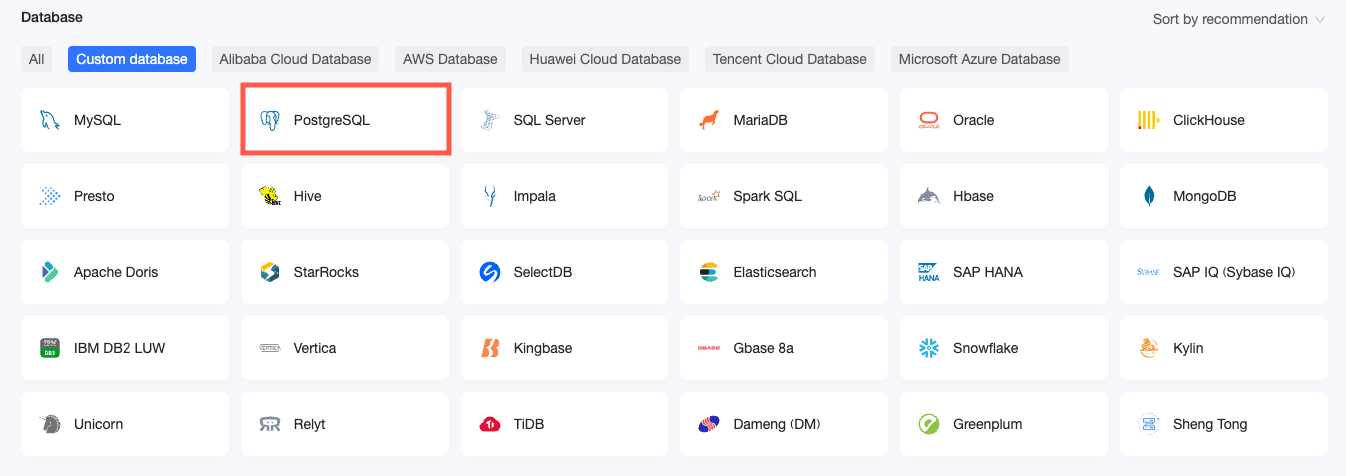This topic explains how to add a user-created PostgreSQL data source.
Prerequisites
Your network should meet the following requirements:
To connect Quick BI to the PostgreSQL database over the Internet, add Quick BI's IP address to the database's whitelist. For more information, see how to add a security group rule.
To connect Quick BI to the PostgreSQL database over an internal network, ensure connectivity using one of the following methods:
If the PostgreSQL database is on an ECS instance, connect Quick BI to the database via a VPC.
Deploy a jump server and access the database through an SSH tunnel.
A user-created PostgreSQL database is in place.
You have the username and password for the user-created PostgreSQL database.
You have obtained the AccessKey ID and AccessKey Secret for authentication.
Limits
Support is available for PostgreSQL version 8.2 and later.
Procedure
Log on to the or the international Quick BI console.
Follow the instructions in the figure below to add a data source.
Navigate to the data source creation page via the data source creation entry.
On the User-created Database tab, select PostgreSQL as the data source.

In the Configure Connection dialog box, complete the following configurations.

Name
Description
Display Name
The display name in the datasource config list.
The name cannot contain special characters or start or end with spaces.
Database Address
The address where the PostgreSQL database is deployed, including the IP address or domain name.
Port
Enter the correct port number. The default port is 5432.
Database
The name of the database that you want to access.
Schema
The schema of the database that you want to access. Default value: public.
Username
The username that is used to connect to the database.
Password
The password that is used to connect to the database.
VPC Data Source
Select this option if you use a virtual private cloud (VPC) to access the data source based on your business requirements. If you select VPC Data Source, you need to configure the following parameters:
Purchaser Accessid: The AccessKey ID of the purchaser of this instance.
For more information, see obtain an AccessKey.
NoteMake sure that the AccessKey ID has the Read permission on the destination instance. If the AccessKey ID also has the Write permission, the system automatically adds the whitelist. Otherwise, you need to manually add it. For more information, see create a custom policy.
Purchaser Accesskey: The AccessKey Secret of the purchaser of this instance.
For more information, see obtain an AccessKey.
Instance ID: The instance ID of the ECS. Log on to the ECS console and obtain the instance ID on the Instances tab.
For more information, see view instance information.
Area: The area where the ECS instance is located.
For more information, see view instance information.
SSL
Select this option if you use SSL as the security protocol for the data source based on your business requirements. If you select SSL, the MaxCompute Lightning interactive search service is supported. For more information, see overview.
SSH
Select this option if you use SSH as the connection method for the data source based on your business requirements. If you select SSH, you need to configure the following parameters:
SSH Host: The hostname or IP address.
SSH Username: The SSH username that is used to connect to the database.
SSH Password: The password of the SSH username that is used to connect to the database.
SSH Port: The port that is used to connect to the database. Default value: 22.
NoteOnly the Professional Edition supports accessing user-created data sources over an SSH tunnel.
Init SQL
After this feature is enabled, you can configure the SQL statements that are executed to initialize the data source connection.
Only SET statements are allowed for the SQL statements that are executed to initialize the data source connection. Separate multiple statements with a semicolon.
Enable file upload entry
After this feature is enabled, you can upload files.
Click Connection Test to verify the data source connectivity.

Once the test is successful, click OK to finish adding the data source.
What to Do next
Once the data source is created, you can proceed to create datasets and analyze data.
Incorporate data tables from the PostgreSQL database or custom SQL into Quick BI. For more information, see how to create and manage datasets.
Create visualization charts and perform data analysis. For more information, see how to create a dashboard and an overview of visualization charts.
Drill down for in-depth data analysis. For more information, see drill settings and display options.